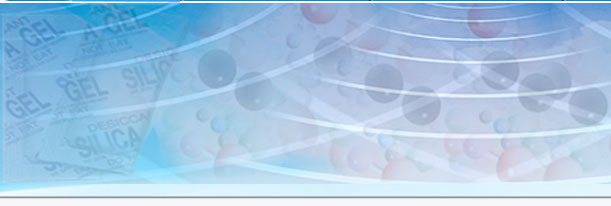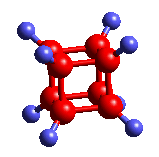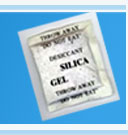Q: What is a desiccant and what does it
do?
A desiccant is a hydrating agent which attracts moisture
from the atmosphere. It adsorbs and holds Particles of
water to itself.
Q: What
is Silica Gel ?
Silica gel is form of silicon dioxide, Si02,
the material that occurs in nature as sand. The difference
between silica gel and sand is that sand is a crystalline,
non-porous form, whereas silica gel is non-crystalline and
highly porous. Silica gel is synthetically manufactured
from the chemical reaction Between sodium silicate and sulfuric
acid.
Silica gel is an amorphous adsorptive substance with stable
chemical properties and has a highly complicated porous
structure. It is odorless, tasteless, and non-toxic, and
offers an excellent capacity for physical and chemical dehumidification
because of good absorbability, chemical stability, wide
surface area and higher mechanical strength. Therefore,
silica gel is used for packing food, pharmaceuticals, goods
for export and precision instruments. Silica gel is easy
to handle and silica gel saturated with moisture can be
regenerated to afford new moisture protection by simply
reheating under specified condition.
A form of silica manufactured from sodium silicate and sulfuric
acid. Like Clay. Silica Gel is non Porous molecular structure
that closely resembles a Sio2 and has the highest capacity
of any commercial desiccant for moisture adsorption.
Q: How are desiccants best
used?
To be used most effectively. desiccants should be used within
a closed/sealed moisture barrier. or a humiditY level and
indicate when the desiccant needs to be replaced.
Q: Who are our customers?
Electronic Parts. Computers. Pharmaceutical and Vitamin
Packaging of Metal Parts. Food Packaging.
Q: So,
silica gel, not really a gel then ?
No, silica gel isn't a gel like a hair gel. It
is a solid material that comes in granular or beaded forms.
These granules or beads are sorted according to their size.
For silica gel in sachets, the grain size is not usually
important, but for uses such as drying flowers, a fine grain
silica gel is more suitable than a large grain silica gel.
A 0.5 -1.0 mm grain size rather than a 1.0 - 3.0 mm or 3.0
- 6.0 mm grain. The larger grain sizes are suited for dynamic
drying applications where air is dried by being passed through
a bed of silica gel.
Q:
But does silica gel get wet as it adsorbs water?
No it doesn't, one tremendous asset of silica gel is that
it traps water molecules inside its pores yet remains totally
dry and appears physically unchanged. It does not swell
or change shape.
Q: Silica gel is a desiccant
then?
Yes, it adsorbs water vapor by physical means, not a chemical
reaction. Water vapor is attracted inside the silica gels
crystalline structure.
Q: Silica gel now comes in
many colors then?
Yes, now it does. Silica gel comes in either non-indicating
or self-indicating forms. Non-indicating silica gel is white
and staves white as it adsorbs moisture. Self-indicating
silica gels have traditionally been impregnated with a moisture
sensitive cobalt chloride indicator. This gives a blue silica
gel which slowly changes color as it adsorbs moisture until
it becomes pink. New self-indicating silica gels feature
a number of other colors (because they have different moisture
sensitive indicators), but all have the same purpose to
indicate when the silica gel is saturated and unable to
take up any more moisture.
Q: Does silica gel comes
ready to use?
Yes. The silica gel does not need to be 'generated' before
use. It is always sold (loose or in sachets) in a dry condition,
ready for use.
Q: How long can ,silica gel
be stored?
Almost indefinitely. The key to retaining a sachets usefulness
is to keep it under air tight conditions until it needs
to be used. Silica gel will adsorb moisture from any environment,
so a sachet left out in the open will immediately start
taking up water vapor. Although the moisture uptake rate
is not fast, small sachets can be vulnerable to such exposure,
as they do not have
large moisture holding capacity. It is recommended that
they are not left open to the atmosphere for longer than
15 minutes. Larger sachets should not be removed from their
packaging more than 1 hour before they are required for
use. The shelf life of silica gel in a sealed environment
can safely be said to be between 4 and 12 months. Practical
experience has shown that it can often far exceed this.
Q:
How much water vapor can silica gel hold?
Silica gel will adsorb up to 40% of its own weight in moisture.
Q: Can silica gel be used
anywhere?
Theoretically yes, but it is really only effective in an
enclosed environment. In a situation where new air (and
moisture) is constantly being introduced, an unpractical
amount of silica gel will likely be needed to keep the Relative
Humidity at low levels.
Q: What is Relative
Humidity ?
Air will always contain water vapor. At any given temperature
there will be a saturation point at which no more moisture
can be retained (anv excess will condense). The Relative
Humidity of air is the actual moisture content expressed
as a percentage of this saturation content. The aim of
using silica gel is to keep the Relative Humidity at levels
below 50% of the saturation capacity. At these levels, corrosion
and mould growth will not be promoted. Problems are often
caused if the temperature drops as the saturation content
of air at the new temperature becomes much lower.
Q: Is silica gel dangerous?
silica gel is non-toxic and non-flammable, it is very inert
with a very high melting point. It is very much like sand
and thus can safely be sent by any means of transport.
Q: How can silica gel work
when it's inside a sachet?
The materials used to make silica gel sachets are specifically
chosen to be breathable. Water vapor passes through them
to be adsorbed by the silica gel.
Q: Why are there so many different
size sachets?
The larger the item that is being protected, the more silica
gel is needed. A range of sachets allows for a single sachet
to be used in most cases.
Q:
And which size sachet should I use?
It will depend on the application. For a well sealed item,
a rule of thumb is that 5 grams of silica gel are needed
for every cubic foot of volume of the package. This converts
to 170 grams per cubic meter.
Can you get non-indicating and self-indicating silica gel
sachets?
Yes. The blue self-indicating silica gels can be seen through
the sachet material.
Q: How is silica gel regenerated?
Self-indicating silica gels when they have become saturated
can be regenerated by heating at 100-120°C until they
return to their original colors. The heating literally drives
off the adsorbed moisture. Regeneration can be carried out
repeatedly, although eventually the crystals will lose their
co lour. When regenerating self-indicating silica gel sachets,
only the minimum necessary heat should be used. This will
prevent the sachet material from deteriorating. Although
non-indicating silica gel can be regenerated in exactly
the same way, it is not apparent when the silica gel is
regenerated other than by checking its weight. it will return
to its original dry weight when completely regenerated.
Non Standard Sizes
And Special Sachets.
The above sachets represent our standard range of off the
shelf items. In addition to this we are able to manufacture
sachets to any other weight that meets customer requirements.
We will also manufacture totally non-standard silica gel
sachets, sachets of specific (and unusual) shape, sachets
with loops or lengths of tape attached, sachets with velcro,
sachets in bandoliers or sachets that are individually over
wrapped in foil or poly pouches. Finally, sachets can be
made using a mixture of materials e.g. silica gel and activated
carbon.
Pricing
And Packing.
We try and sell sachets in almost any quantity that we are
asked for. They are supplied in strong cartons with heavy
gauge poly bags. If required, packaging can be tailored
to suit individual needs In generate non-indicating silica
gel sachets are cheaper than self-indicating sachets and
to double the weight of silica gel does not double the cost.
Prices are tiered, with price breaks as quantities increase.
Often dramatic decreases in cost will accompany increased
quantities.
|




















